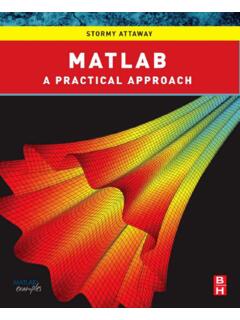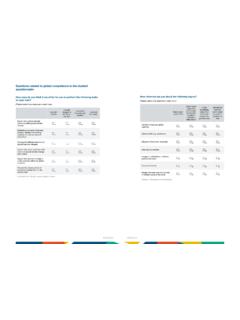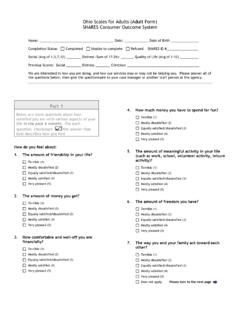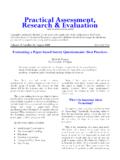Transcription of 681 topic report - Home page Matematickog fakulteta
1 Likert Scales are the meaning of life: Dane Bertram Note: A glossary is included near the end of this handout defining many of the terms used throughout this report . CPSC 681 topic report Dane Bertram Likert Scale \lick urt\, n. Definition: A psychometric response scale primarily used in questionnaires to obtain participant's preferences or degree of agreement with a statement or set of statements. Likert scales are a non comparative scaling technique and are unidimensional (only measure a single trait) in nature. Respondents are asked to indicate their level of agreement with a given statement by way of an ordinal scale. Variations: Most commonly seen as a 5 point scale ranging from strongly Disagree on one end to strongly agree on the other with Neither agree nor Disagree in the middle; however, some practitioners advocate the use of 7 and 9 point scales which add additional granularity. Sometimes a 4 point (or other even numbered) scale is used to produce an ipsative (forced choice) measure where no indifferent option is available.
2 Each level on the scale is assigned a numeric value or coding, usually starting at 1 and incremented by one for each level. For example: Figure 1. Sample scale used in Likert scale questions Origin: Named after Dr. Rensis Likert, a sociologist at the University of Michigan, who developed the technique. His original report entitled A Technique for the Measurement of Attitudes was published in the Archives of Psychology in 1932. His goal was to develop a means of measuring psychological attitudes in a scientific way. Specifically, he sought a method that would produce attitude measures that could reasonably be interpreted as measurements on a proper metric scale, in the same sense that we consider grams or degrees Celsius true measurement scales (Uebersax, 2006). From Example: Suppose we are comparing the opinions of Masters and PhD students in CPSC. Please indicate how much you agree or disagree with each of the following statements: strongly somewhat Neither agree somewhat strongly disagree disagree nor disagree agree agree 1.
3 The U of C This is now website is easy to use. 1 2 3 4 5 2. The My U of C website is easy to use. 1 2 3 4 5 3. The Peoplesoft Student Center website is easy to use. 1 2 3 4 5 Likert Scales 1 | P a g e CPSC 681 topic report Dane Bertram Analysis: Each specific question (or item ) can have its response analyzed separately, or have it summed with other related items to create a score for a group of statements. This is also why Likert scales are sometimes called summative scales. For our example we will evaluate the results as a whole using descriptive statistics, and also the specific results for question 1 (see Mann Whitney U test section below). Individual responses are normally treated as ordinal data because although the response levels do have relative position, we cannot presume that participants perceive the difference between adjacent levels to be equal (a requirement for interval data). In practice, many researchers do treat Likert scale response data as if it were interval data; however, from a statistical standpoint this can be dangerous.
4 For example, there is no way to ensure that participants view the difference between agree and strongly agree the same as they might view the difference between agree and neutral. The average of fair' and good' is not fair and a half'; which is true even when one assigns integers to represent fair' and good'! Susan Jamieson paraphrasing Kuzon Jr et al. (Jamieson, 2004) The raw data for our example is outlined in Table 1 below. The participant responses have been grouped according to Masters and PhD students in order to help relate this data to the statistics we will calculate in the following sections. Participant ID Category Q1. President Q2. GSA Q3. CSGS 1 4 4 3 2 3 4 3 3 4 3 2 4 2 3 4 MSc 5 5 3 3 6 4 2 2 7 3 3 3 8 4 4 4 9 3 4 3 10 2 5 2 11 2 4 2 12 4 1 3 PhD 13 1 3 2 14 2 2 3 15 4 3 3 16 1 1 2 Table 1. Raw Data Likert Scales 2 | P a g e CPSC 681 topic report Dane Bertram Tables 2, 3, 4, and 5 provide two variations of the descriptive statistics that can be calculated for the above data.
5 Tables 2 and 3 show the median, mode, range, and inter . quartile range for the raw data where Table 2 treats all the responses together as a whole and Table 3 breaks down the same statistics into our two participant categories (Masters and PhD students) in order to aid in the comparison of these groups. Median Mode Range Inter quartile Range Q1. U of C 3 4 4 2 Q2. My U of C 3 3 4 Q3. Peoplesoft 3 3 2 1 Table 2. Descriptive Statistics 1A Median Mode Range Inter quartile Range MSc PhD MSc PhD MSc PhD MSc PhD Q1. U of C 4 2 4 2 3 3 1 Q2. My U of C 3 3 3 4 2 4 1 Q3. Peoplesoft 3 3 3 2 1 1 Table 3. Descriptive Statistics 1B Tables 4 and 5 go on to aggregate the number of responses for each Likert level in each question where Table 4 again treats all the responses as a whole while Table 5 distinguishes between Masters and PhD student responses. strongly somewhat Neither agree somewhat strongly agree disagree disagree nor disagree agree Q1. U of C # 2 4 3 6 1 % 13% 25% 19% 38% 6% Q2.
6 My U of C # 2 2 6 5 1 % 13% 13% 38% 31% 6% Q3. Peoplesoft # 0 6 8 2 0 % 0% 38% 50% 13% 0% Table 4. Descriptive Statistics 2A Likert Scales 3 | P a g e CPSC 681 topic report Dane Bertram strongly somewhat Neither agree somewhat strongly agree disagree disagree nor disagree agree MSc PhD MSc PhD MSc PhD MSc PhD MSc PhD Q1. U of C # 0 2 1 3 2 1 4 2 1 0 % 0% 25% 13% 38% 25% 13% 50% 25% 13% 0% Q2. My U of C # 0 2 1 1 4 2 3 2 0 1 % 0% 25% 13% 13% 50% 25% 38% 25% 0% 13% Q3. Peoplesoft # 0 0 2 4 4 4 2 0 0 0 % 0% 0% 25% 50% 50% 50% 25% 0% 0% 0% Table 5. Descriptive Statistics 2B Methods: Depending on how the Likert scale questions are treated, a number of different analysis methods can be applied: 1. Analysis methods used for individual questions (ordinal data): bar charts and dot plots not histograms (data is not continuous) central tendency summarised by median and mode not mean variability summarised by range and inter quartile range not standard deviation analyzed using non parametric tests (differences between the medians of comparable groups) Mann Whitney U test (see below) Wilcoxon signed rank test Kruskal Wallis test 2.
7 When multiple Likert question responses are summed together (interval data): all questions must use the same Likert scale must be a defendable approximation to an interval scale ( coding indicates magnitude of difference between items, but there is no absolute zero point) all items measure a single latent variable ( a variable that is not directly observed, but rather inferred from other variables that are observed and directly measured) analyzed using parametric tests analysis of variance (ANOVA) 3. Analysis methods used when reduced to nominal levels of agree vs. disagree: Chi square test Cochran Q test McNemar test Likert Scales 4 | P a g e CPSC 681 topic report Dane Bertram Mann Whitney U test: To give an example of how you might evaluate a single Likert scale question we will use the Mann Whitney U test (also called the Mann Whitney Wilcoxon, Wilcoxon rank sum test, or Wilcoxcon Mann Whitney test) to compare the opinions of Masters vs. PhD students with respect to the usability of the main U of C website (question 1 from the example).
8 This is a non . parametric test, and is therefore well suited to our Likert scale data as we cannot presume that the underlying population fits a normal distribution (or any other parameterized distribution for that matter). This test requires that our two samples be statistically independent ( results from one sample do not affect results in the other sample), and that the observations be ordinal. We can use this method to test the null hypothesis that there is an equal probability that an observation from one sample will exceed an observation from the other sample . essentially stating that the two samples come from the same population. Running the Mann Whitney U test: the U statistic. To calculate the U statistic we combine the observation values from both samples and write them down in rank order. Below each observation value we mark which sample it came from (alternating between the two samples when the same observation value is repeated and can be seen in both samples).
9 This has been done with the observation values for question 1 as follows (P = PhD sample, M = MSc sample): Rank ordered: 1, 1, 2, 2, 2, 2, 3, 3, 3, 4, 4, 4, 4, 4, 4, 5. Origin sample: P, P, M, P, P, P, M, P, M, M, P, M, P, M, M, M. Next, moving from left to right, we take each observation from sample 1 (Masters students' responses) and count the number of observations from sample 2 (PhD students' responses) occurring after it (to the right) in the list. When there are matching responses (the same observation value) from each sample we count a half. For example, with the first Masters student response we have the following: Tie Rank ordered: 1, 1, 2, 2, 2, 2, 3, 3, 3, 4, 4, 4, 4, 4, 4, 5. Origin sample: P, P, M, P, P, P, M, P, M, M, P, M, P, M, M, M. Since there is a tie, we count and then 1 for each of the PhD responses (after the tie) appearing to the right of this Masters response in the list giving us a count of For the second Masters student response we have the following: Tie Rank ordered: 1, 1, 2, 2, 2, 2, 3, 3, 3, 4, 4, 4, 4, 4, 4, 5.
10 Origin sample: P, P, M, P, P, P, M, P, M, M, P, M, P, M, M, M. Likert Scales 5 | P a g e CPSC 681 topic report Dane Bertram Again we have a tie, so we count and then 1 for each additional PhD response appearing to the right giving us a count of For the third Masters student response we don't have a tie, so we simply count 1 for each PhD response appearing to the right giving us a count of 2. This process continues until we've calculated a count for each of the Masters student responses. These counts are added together to give us the U statistic when starting the counting process with sample 1: UMSc = + + 2 + + + 0 + 0 + 0 = 12 Similarly, we perform the same calculation for each observation from sample 2. In this example there is no tie for the first PhD student response and all of the Masters student responses come after it in the list, giving a count of 8. Just as before, we continue this process for each PhD student response yielding the following U statistic when starting with sample 2: UPhD = 8 + 8 + + 7 + 7 + + + = 52 Note: A convenient check to ensure your numbers are correct is to ensure that: U1 + U2 = (# of observations in Sample 1) x (# of observations in Sample) This check works because in the most extreme case, all the values from one sample would come before the values from the other sample.











